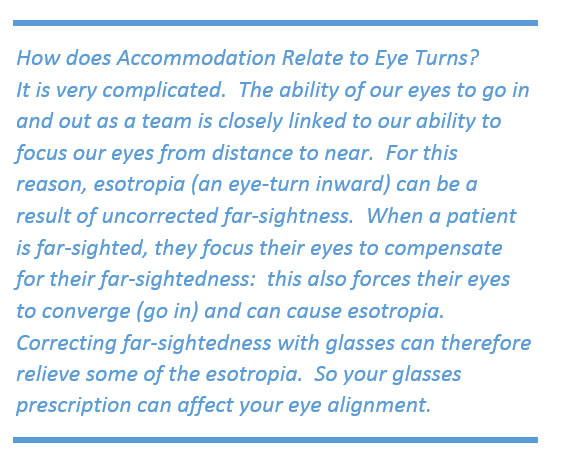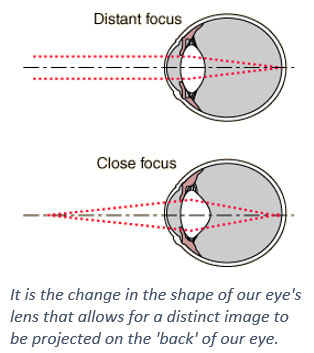Accommodation: The Eyes Focusing System
Accommodation and Accommodative Facility are key visual efficiency skills that allow our visual system to switch accurately and quickly between looking at objects at a distance and at near. Accommodative disorders in children can be treated with vision therapy, but in adults, they can only be treated with glasses.
Our eyes are much like a high-end camera in that they can only focus at one distance at a time. Since it is 'automatic' for people to switch the depth that they are focused on, you may take this ability for granted. But if you place a finger close to your face while maintaining focus on these words, you will quickly realize that the finger is blurry because it is not in focus. Now imagine being a child who has an underdeveloped accommodative system! They look at an object, but it does not become clear, or it takes an excess effort to become clear.
Eye conditions relating to Accommodation:
Children - Accommodative Dysfunction
 Accommodative dysfunction is a rare problem that occurs when children are unable to accommodate despite having an intact lens and eye muscles that are used for accommodation. This problem usually 'fixes' itself by age 10, but if a child has accommodative dysfunction throughout elementary school, it may affect their learning before it gets better. Your optometrist may recommend vision therapy or reading glasses for a child with accommodative dysfunction.
Accommodative dysfunction is a rare problem that occurs when children are unable to accommodate despite having an intact lens and eye muscles that are used for accommodation. This problem usually 'fixes' itself by age 10, but if a child has accommodative dysfunction throughout elementary school, it may affect their learning before it gets better. Your optometrist may recommend vision therapy or reading glasses for a child with accommodative dysfunction.
Children - Accommodative Infacility
 Accommodative Facility is the ability to quickly and precisely switch between focusing at near to focusing at far and back. To have accommodative Infacility is to be unable to quickly switch between near and far focus. This is especially detrimental to children who need to look back and forth between the board and their school work in front of them. Your optometrist may recommend vision therapy or reading glasses for this problem depending on co-diagnosis.
Accommodative Facility is the ability to quickly and precisely switch between focusing at near to focusing at far and back. To have accommodative Infacility is to be unable to quickly switch between near and far focus. This is especially detrimental to children who need to look back and forth between the board and their school work in front of them. Your optometrist may recommend vision therapy or reading glasses for this problem depending on co-diagnosis.
Children - Accommodative Spasm
Accommodative spasm is when a child's eye over accommodates. At first glance, your optometrist may believe your child is near-sighted because the accommodative system is active even when the child is looking into the distance. This will create blur at a distance and headaches from overstraining the accommodative eye muscles. Your optometrist may recommend vision therapy, cycloplegic medication, or reading glasses for this problem depending on co-diagnosis.
Adults - Presbyopia
Presbyopia is not a sight or life-threatening condition; it is just a normal part of aging. It occurs around age 40. Presbyopia is the loss of one's ability to focus one's eyes, leading to blurry vision at near unless multifocal glasses (such as progressive or bifocal lenses) are used.
I recommend progressive lenses to most of my presbyopic patients. Progressive lenses work by having a different prescription at the top and bottom of the lens—At the top will be your normal distance prescription; at the bottom will be your reading prescription. That way, when you look downward to read, you are looking through your reading prescription. Progressive lenses have an advantage over traditional lined bifocals because Progressive lenses have an intermediate zone that can be used to see at intermediate distances, such as a computer monitor. You will find that progressives range in quality and price. You should get the progressives you feel comfortable paying for, but I warn you against going with the cheapest off-brand types of progressives because your quality of vision will suffer. Likewise, some of the most expensive types of progressive lenses are disproportionately expensive. Our opticians are trained to help you find mid to upper-range quality progressives at a good price.
